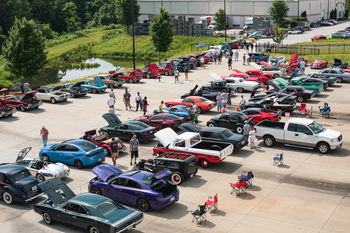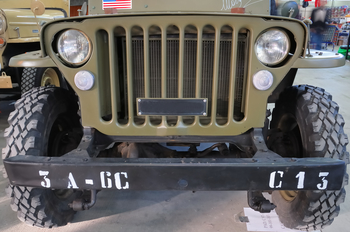SEMA News—December 2020
LEGISLATIVE AND TECHNICAL AFFAIRS
By Stuart Gosswein
2020: The Year in Review
 Bonneville Salt Flats: The Utah Department of Natural Resources and U.S. Bureau of Land Management (BLM) signed an agreement to create the “Restore Bonneville” program and dramatically increase the amount of salt currently being pumped onto the historic landmark. Bonneville’s salt crust diminished over many decades after the BLM issued leases allowing salt to be transferred for potash mining. Salt thickness measurements are now in inches rather than feet. While mining adjacent to Bonneville historically contributed to the diminishment of the salt crust, it is also part of the restoration solution. Once potash is extracted from salt brine through a solar evaporation process, the remaining salt is a waste byproduct owned by the mine lease holder. The mine owner has been pumping salt since 1997, but infrastructure renovation and upgrades will increase the volume. As a result, the racing venue should gradually expand from its current 8-mi. length, with a goal of reaching the original 13-mi. length. SEMA, along with other organizations and companies comprising the Save the Salt Coalition, is working with state and federal officials to implement the 10-year program. The state of Utah and the BLM have allocated $2 million to start the program, and additional funds are being pursued for 2021. |
The laws and regulations that govern how SEMA members do business have a continuous impact on the way automotive specialty-equipment products are made, distributed and marketed. The charge of the SEMA government affairs office is to stay on top of all relevant state and federal legislation and regulations and advocate for industry positions to ensure the best possible outcome for SEMA’s membership. The following are a few examples of critical legislative/regulatory issues addressed by the SEMA government affairs team over the past year.
FEDERAL UPDATE
COVID-19: Addressing COVID-19 as a nation and industry was the top challenge of 2020. The legislative agenda for most states and the federal government was significantly impacted as lawmakers turned their attention to pandemic relief measures. SEMA focused on providing members with valuable resources, including webinars and the creation of the www.sema.org/coronavirus webpage. The focus of attention included:
- Closures and Reopenings: SEMA compiled a database on how each state defines which businesses are “essential” and then worked with other organizations to define essential auto industry work activities within the U.S. Department of Homeland Security guidelines and those adopted by the states. The database then tracked state-by-state reopenings.
- Small-Business Loans: The U.S. Small Business Administration (SBA) administered the Paycheck Protection Program to provide small businesses with 1%-interest-rate loans for operation costs. The loans were potentially forgivable if at least 60% of the loan was used for payroll. Pending legislation supported by SEMA would require the SBA to create a simple one-page application form to automatically forgive qualifying loans up to $150,000. The SBA had a second program for granting an emergency coronavirus disaster loan of up to $2 million at 3.75% interest to be used for payroll, fixed debts, accounts payable and other bills, including a $10,000 forgivable grant.
- COVID-19 Liability Protection: SEMA continues to urge the U.S. Congress to pass targeted COVID-19 protection from the threat of frivolous liability lawsuits. The protection would be granted to businesses operating under applicable public health guidelines for the duration of the pandemic. Many states have enacted such legislation, but efforts to enact a national standard have stalled.
- Tax Credits: The Internal Revenue Service provided a variety of relief measures, from deferring tax filing deadlines to providing employer tax credits.
- Paid Sick and Family Leave: Lawmakers expanded federal laws covering paid sick and family leave policies to address health and stay-at-home challenges.
- OSHA and CDC Guidance: The Occupational Safety and Health Administration developed employer guidance for creating a safe workplace, and the Centers for Disease Control and Prevention issued comprehensive guidance on understanding the virus and mitigating exposure.
RPM Act: The Recognizing the Protection of Motorsports (RPM) Act is being considered by the U.S. Congress. The bill (H.R. 5434; S. 2602) clarifies that the Clean Air Act allows motor vehicles to be converted into dedicated race cars and that it is legal to produce, sell and install race parts for those vehicles. Passage of the RPM Act will protect sales beyond emissions-related parts, including racing tires, wheels, brakes, suspension equipment and rollcages, since customers won’t be installing those products if a car or motorcycle cannot be converted into a dedicated race vehicle. The bill has been subject to
previous Congressional hearings, and SEMA is working with lawmakers to approve the legislation in the current Congress. To contact your lawmakers, visit www.sema.org/rpm.
 Collector Car Appreciation Day: The 11th annual Collector Car Appreciation Day (CCAD) took place on Friday, July 10, 2020. Both the U.S. Senate and the House of Representatives introduced resolutions (H.R. 998/S.R. 650) to focus attention on the vital role automotive restoration and collection plays in American society. Thousands of Americans gathered at car cruises, parades and virtual events to celebrate the nation’s automotive heritage. The day is also international in scope, as many Canadian provinces passed resolutions and hosted events. The next CCAD is set for July 9, 2021. |
Tariffs: SEMA is working with several coalitions of industry associations to oppose the imposition of tariffs on a variety of worldwide products and materials. While SEMA supports the Trump administration’s efforts to create fair and reciprocal trade and to protect intellectual property rights, the association remains concerned that tariffs are not accomplishing that shared objective. SEMA has called for tariff relief during COVID-19. The first request was for a temporary suspension of tariff collections so that companies could preserve cash and pay other bills. The second request was for an extended deferral of collections. To date, both requests have been denied. The following is a summary of specific tariffs.
Steel/Aluminum: The U.S. government has imposed global tariffs on steel (25%) and aluminum (10%). Most of the tariffs began on June 1, 2018, with Argentina, Australia, Brazil and South Korea being exempted based on trade agreements. Mexico and Canada were exempted on May 20, 2019. The tariffs generally apply to processed raw materials (steel/aluminum plate, sheets, bars, etc.) but not finished products (e.g., wheels, exhaust systems, etc.). However, the U.S. government has imposed the tariffs on several product categories, including bumper stampings, for which it has documented a dramatic increase in the volume of imports that could be construed as circumventing the tariffs. U.S.-based companies are eligible for one-year tariff exclusions if they can demonstrate that the foreign-produced material is not made in the U.S. in reasonably available quantity or satisfactory quality. More than 200,000 company exclusion requests have been received to date.
Chinese Products: In July 2018, the United States began imposing tariffs on most imports from China. Tariffs on auto parts began in September 2018 at 10% and were raised to 25% in May 2019. In January 2020, the United States and China signed a phase-one trade deal whereby China will buy more U.S. goods and implement intellectual property enforcement measures and provisions to end the practice of pressuring foreign companies to transfer their technology to Chinese companies. The tariffs were thought to be bargaining chips that would be removed once a trade agreement had been negotiated. However, they remain as leverage to confirm China’s phase-one compliance and pursue a phase-two agreement to address the trade imbalance issues, cybertheft and Chinese subsidization of key industries. There is no timetable for reaching a phase-two agreement. Companies were able to seek tariff exclusions based on hardship and a lack of alternative product sourcing, but a majority of requests were denied, and all exclusions are scheduled to end on January 1, 2021.
Imported Autos/Auto Parts: In May 2018, President Trump directed the U.S. Department of Commerce to investigate whether to impose tariffs on imported automobiles and auto parts if it is found that they pose a threat to America’s national security (manufacturing base). The Department of Commerce report has not been released but is believed to note concerns about increases in the volume of automobile and auto part imports over the past three decades, along with barriers to sales of U.S. exports in foreign markets. A focus of concern is innovations in engine and powertrain technology, electrification, lighter-weight materials, advanced connectivity and autonomous driving. In response to threatened tariffs, SEMA and seven other major trade associations representing the broad scope of the auto industry formed the Driving American Jobs Coalition. The coalition opposes the tariffs as being counterproductive and threatening American companies, workers and consumers.
Replica Vehicle Law: A SEMA-supported law enacted in 2015 will allow small auto manufacturers to sell completed replica cars. Those vehicles resemble cars manufactured at least 25 years ago. Companies will be able to produce up to 325 turnkey replica vehicles (per company) in the United States and 5,000 worldwide under a simplified regulatory system. Until now, the federal government’s regulatory system did not differentiate between a company producing millions of vehicles and a business producing a few custom cars. In 2019, SEMA sued the National Highway Traffic Safety Administration (NHTSA) for failing to implement the program in 2016 as required under the law. The lawsuit helped spur the NHTSA to issue a proposed rule in January, and the industry is now awaiting issuance of a final rule that will allow car sales to commence. In 2019, the U.S. Environmental Protection Agency (EPA) and the California Air Resources Board (CARB) issued guidelines and regulations covering the engine packages to be installed in these replica vehicles.
Digital Millennium Copyright Act: SEMA filed a petition with the Copyright Office to renew an existing exemption allowing vehicle owners and service and repair shops to diagnose, repair or modify a vehicle without violating copyright protections. Congress passed the Digital Millennium Copyright Act in 1998 to ensure that copyright law extended to digital products and services. Congress also included a process for securing three-year exemptions that can be renewed indefinitely when a need to access copyrighted material can be demonstrated, such as accessing vehicle software to repair a vehicle or install aftermarket products.
Federal Enforcement Practices: SEMA submitted comments to the White House Office of Management and Budget (OMB) on ways to improve regulatory enforcement practices employed by the federal government. The comments included examples of excessive practices being employed by the U.S. EPA, such as unscheduled inspections, failure to inform company employees of the right to deny entry and consult with an attorney, overly broad investigations, and the threat of exorbitant fines as a negotiating strategy. SEMA recommended that the OMB issue guidelines requiring that government enforcement procedures take small business size into consideration.
“Made in USA” Regulation: The Federal Trade Commission (FTC) is proposing to issue a regulation to consolidate its longstanding policy to enforce unqualified “Made in USA” claims. For decades, the agency has used its general legal authority to enforce against unfair or deceptive trade practices regarding unqualified “Made in USA” claims. The FTC has issued broad guidance on the topic, most recently in 1997, but has not issued a formal regulation until now. The FTC is not pursuing any changes of substance to its policy, which requires a seller making an unqualified “Made in USA” claim to have a reasonable basis for asserting that “all or virtually all” of the product is made in the United States. Companies may still make qualified “Made in USA” claims for products that include U.S. content or processing but do not meet the criteria for making an unqualified claim. Qualified claim examples include “Made in USA of U.S. and Imported Parts,” “75% U.S. Content,” and “Assembled in USA.”
Tire Dumping Petitions: The United Steelworkers union has filed petitions alleging that certain light-truck and passenger-vehicle tires from Southeast Asia are being dumped or are benefitting from unfair government subsidies. The petitions cite dumping margins as high as 195% for Korea, 147% for Taiwan, 217% for Thailand and 33% for Vietnam. The U.S. International Trade Commission must confirm that there is harm or threatened harm to U.S. industry before duties can be imposed.
NAFTA/USMCA: The United States-Mexico-Canada Agreement (USMCA) to replace the North American Free Trade Agreement (NAFTA) was ratified and implemented by the three countries. Major provisions include a requirement that vehicles have at least 75% North American content, compared with 62.5% currently. At least 40%–45% of the vehicle content must be made by workers earning at least $16 an hour, which will lead to higher wages in Mexico.
Maintenance Backlog on Federal Lands: The SEMA-supported Great American Outdoors Act (GAOA) was signed into law in August. The GAOA will dedicate $9.5 billion over the next five years to address the maintenance backlog on federal lands by creating a national parks and public land legacy restoration fund, enabling the National Park Service, the U.S. Forest Service and several other federal agencies to rebuild and improve trails, roads, docks, campgrounds and more. The bill will also appropriate $900 million annually to the Land and Water Conservation Fund for projects that help to protect natural areas, water resources, cultural heritage sites, and to provide recreation opportunities. The GAOA will benefit many SEMA members in the off-road market, in addition to companies selling wheels/tires, suspension, power and other equipment to help tow RVs and boats to the nation’s parks and recreation areas.
 West Virginia—Military Vehicles: West Virginia Governor Jim Justice signed into law a SEMA-supported bill to allow antique military vehicles to display an alternate registration insignia, as opposed to a traditional license plate. Antique vehicle plates are available for vehicles that are more than 25 years old and owned solely as collectors’ items. West Virginia—Military Vehicles: West Virginia Governor Jim Justice signed into law a SEMA-supported bill to allow antique military vehicles to display an alternate registration insignia, as opposed to a traditional license plate. Antique vehicle plates are available for vehicles that are more than 25 years old and owned solely as collectors’ items. |
STATE UPDATE
Collector Car Appreciation Day: The states of Louisiana, South Dakota, West Virginia and Wisconsin, along with the Canadian provinces of Alberta, British Columbia, Newfoundland and Labrador, New Brunswick, and Nova Scotia, passed SEMA-requested resolutions locally recognizing Collector Car Appreciation Day.
COVID-19 Liability Protection: Georgia, Louisiana, Kansas, Mississippi, Nevada, North Carolina, Ohio, Oklahoma, Tennessee, Utah and Wyoming each enacted SEMA-supported laws to provide businesses that follow public health guidance protection from unreasonable lawsuits related to the COVID-19 pandemic.
California—Electric Vehicles: California Governor Gavin Newsom issued a controversial Executive Order in September instructing the California Air Resources Board to draft regulations requiring that all new cars and passenger trucks sold in the state be zero-emissions by 2035. Once drafted, CARB’s proposed regulations will be subject to a lengthy regulatory process, including legal, economic and environmental analyses, public comment, and hearings. According to the California Energy Commission, zero-emission vehicles (ZEVs) currently make up approximately 2% of the more than 28 million vehicles in use in the Golden State. It is estimated that at least 8% of new-vehicle sales in California will be ZEVs and plug-in hybrids by 2025. SEMA opposes the governor’s order, which is expected to face numerous legal challenges. California’s ZEV program falls within the state’s greenhouse gas rule, which is being challenged in court by the Trump administration. The federal government is seeking to withdraw EPA recognition of the California rule under the Clean Air Act because it effectively establishes fuel economy standards that are the sole jurisdiction of the federal government. The challenge could eventually be decided by the Supreme Court.
Maryland—Historic Vehicles: The Maryland House of Delegates withdrew SEMA-opposed legislation that would have imposed an emissions inspection requirement on historic vehicles less than 40 years old. All historic vehicles are currently exempt. In Maryland, a historic vehicle is defined as being 20 years old or older and not substantially altered from the manufacturer’s original design.
 Virginia—Motorsports: SEMA-supported legislation in Virginia to create a motor vehicle racing heritage trail in order to promote tourism and economic development became law after the deadline for Governor Ralph Northam’s signature or veto passed. The law convenes a group of stakeholders, including owners of historic NASCAR and other racing tracks, to design and implement the trail. Virginia—Motorsports: SEMA-supported legislation in Virginia to create a motor vehicle racing heritage trail in order to promote tourism and economic development became law after the deadline for Governor Ralph Northam’s signature or veto passed. The law convenes a group of stakeholders, including owners of historic NASCAR and other racing tracks, to design and implement the trail. |
New Jersey—Vehicle Warranties: New Jersey Governor Phil Murphy signed into law SEMA-supported legislation to require new-car dealers to provide purchasers written notice that it is illegal for manufacturers or dealers to void a warranty or deny coverage because aftermarket or recycled parts were installed or because someone other than the dealer performed service.
Ohio—License Plates: SEMA-supported legislation from 2019 allowing the display of only a single, rear-mounted license plate went into effect on July 1, 2020. The state previously required both a front and a rear plate. This new law is expected to save the state between $1.2 and $1.4 million
per year.
Oklahoma—License Plates: The Oklahoma House of Representatives failed to pass SEMA-opposed legislation that would have required front and rear license plates on all vehicles. Vehicles are currently required to display only a single, rear-mounted license plate.
Washington—Vehicle Registration: SEMA-opposed legislation that would have significantly restricted eligibility of collector vehicles and horseless carriages failed to pass when the legislature adjourned for the year. Under existing law, a collector vehicle must be at least 30 years old, while a horseless carriage must be at least 40 years old. If passed, collector vehicles would have been required to be at least 40 years old, while horseless carriages would have been defined as being manufactured prior to 1916. The bill would also have restricted the issuance of year-of-manufacture plates and considerably increased registration fees.
Wisconsin—Collector and Hobbyist Vehicles: SEMA-opposed legislation in Wisconsin to restrict eligibility and raise fees for collector and hobbyist vehicle registrations failed to pass the Assembly. Currently, these vehicles must be more than 20 years old and are required to pay twice the registration fee as the type of vehicle being registered. If passed, the bill would have further limited each designation to vehicles 30 years old and older, expanded seasonal use restrictions, and increased the registration fees to three times the normal rate. In Wisconsin, a collector vehicle is defined as being at least 20 years old, preserved because of historical significance, and having had no body alterations. Vehicles eligible for hobbyist plates include street modifieds, replica vehicles, reconstructed vehicles and homemade vehicles.






